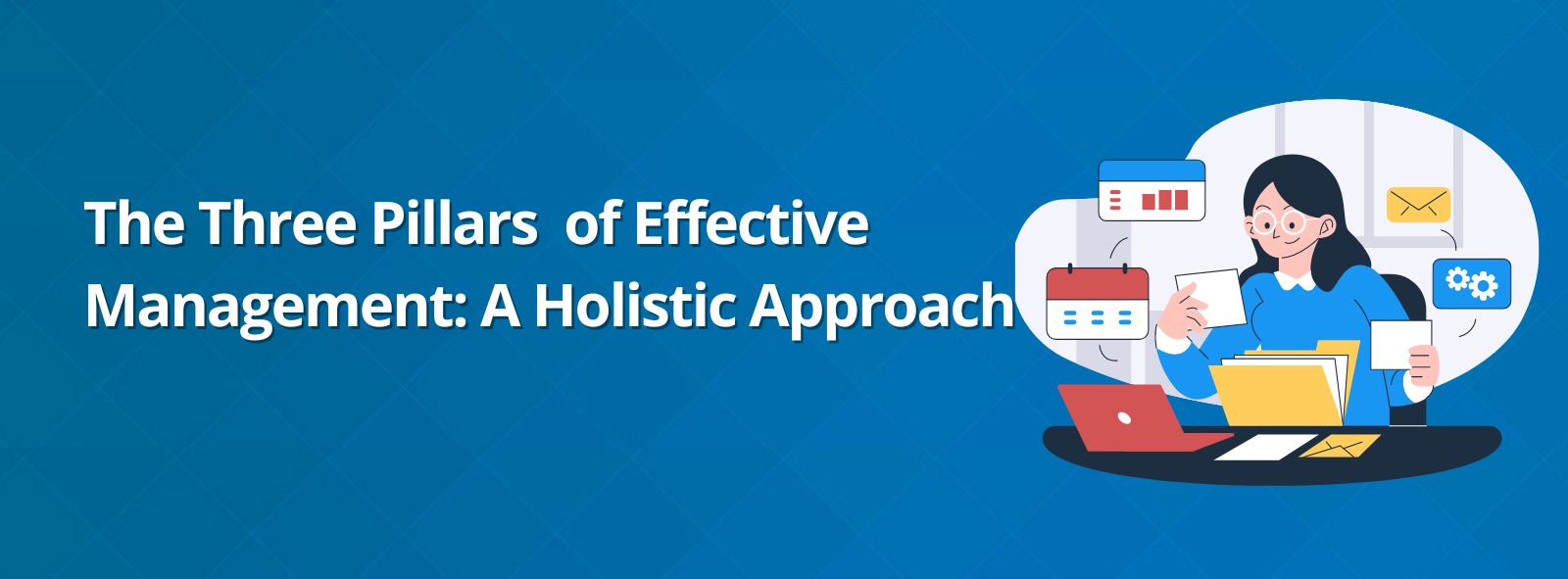In the dynamic world of leadership and management, it’s crucial to have a plan that can respond to evolving changes while respecting what we know about how human beings develop capacity at work.
Drawing upon years of experience in crafting management courses, interviewing numerous managers, and training leaders in essential skills, I propose the following holistic framework. Effective management, from my perspective, rests upon three interwoven pillars: self-regulation, differentiation, and high-level thought integrated throughout and responsive to operations.
Category #1: SELF REGULATION
The foundation of effective management begins with self-regulation – a delicate balance of self-awareness, empathy, and the ability to adapt.
a. Self-awareness and Self-governance:
Evidence of effective self-regulation lies in the increased ability to notice and manage emotions, fostering calm and peaceful behavior.
Other awareness and empathy contribute to professional judgment, resulting in organizational growth and a high happiness index.
b. Change and Sustain Habits:
Effective managers continuously evolve, breaking free from routines and known limits.
Continuous learning and the application of knowledge to work habits serve as evidence of this dynamic self-transformation.
Natalia’s story part 1
Noticing that she is getting increasingly irritated with an employee who reports to her, Natalia decides to take a few minutes to write down what is bothering her about the employee. She realizes that this employee consistently asks her questions about things that are already covered in previous meetings and for which there are reference documents. She decides to first calm herself down by doing some breathing exercises and then makes a statement about how she would like to have the employee show up – by first looking at the existing meeting minutes and reference documents before coming to Natalia with questions. She feels calmer and decides to set up a meeting with the employee. Because she realizes she has a habit of putting of potentially unpleasant conversations, she tells herself “Do it now Natalia” and asks the employee when today or tomorrow they could meet for 30 minutes.

Category #2: DIFFERENTIATION
The second pillar revolves around differentiation – the ability to separate identity from biases, inspire creativity, and balance encouragement with challenge.
a. Separation of Identity from Bias:
Effective managers see people as they wish to be seen, fostering unity of thought.
The capacity to hold different points of view without attachment enhances adaptability.
b. Inspire and Be Inspired:
Creativity thrives when managers inspire and are inspired by others, resulting in a joyful and appreciative work environment.
c. Balancing Encouragement and Challenge:
Encouraging growth and allowing for mistakes sets a high standard for excellence in both means and ends.
Team behaviors become more balanced, fostering a culture of encouragement and challenge.
d. Read Reality without Hopelessness:
Effective managers face difficulties without succumbing to hopelessness.
The power of the human spirit to rise and shine becomes evident in challenging situations.
Natalia’s story part 2:
Natalia has arranged to meet with her employee. She starts by asking him about his plans for the weekend. Then she asks “How are things going in your work and at home lately?” and listens carefully to the answer. She discovers that she and her employee both have an interest in basketball and that he is worried about having had his credit card compromised a couple of weeks ago. This helps her to see him in a more favourable light and to know him better as a person.
She then says that when she is worried she remembers the quote “Everything works out in the end and if it hasn’t worked out it isn’t the end yet”. He laughs and says this makes him feel better about the credit card issue.
Natalia then explains that when people get stressed they need to calm themselves down first before running to their managers for help. She asks him what he does to calm himself down and he says he goes to the gym but hasn’t had time for the past two weeks. Natalia says “Clearly going to the gym is helpful for you,” and then explains that when he is calmer, he will know to look up the answer to his question in the last meeting minutes or the reference manual before coming to her with a question. She asks him if he can do that and says she has faith in his capacity to calm himself down and look things up.
The next time he comes to her office Natalia asks “Have you calmed yourself down and checked if you already have the answer?” He turns around and comes back again 15 minutes later with the words “I’m calm now and I already looked this up but I still need help with one part”. Mostly he is improving but it isn’t yet consistent.
Natalia reminds herself “It takes 67 tries for an adult to learn a new behaviour.” Then she makes a list of the times he has already shown the behavior she wants and realizes she has not acknowledged how much progress he has already made and goes back to show him that progress.

Category #3: HIGH LEVEL THOUGHT INTEGRATED THROUGHOUT AND RESPONSIVE TO OPERATIONS
The third pillar emphasizes principle-based discussions, collective decision-making, and the ability to translate thought into action.
a. Principle-Based Discussions:
Respect for individual inputs, stages of development, and careful consideration of cases lead to a deeper understanding of how principles affect outcomes.
b. Collective Decision-Making:
Encouraging honest and kind participation in decision-making fosters altruism and generosity.
Agreed-upon solutions benefit the whole, avoiding exclusion of individuals or groups.
c. Translate Thought into Action:
Effective managers speak with the intent of putting words into action, minimizing ego and promoting collective success.
Natalia’s story part 3:
Natalia decides the problem of people not doing the research or trusting their judgement is not confined to one employee. At the next staff meeting she tells the team that she wants to increase everyone’s ability to research answers to their questions and then trust that they can act on it as long as it is within their job description. They talk with a partner about why they might not be able to answer their questions without coming to the boss and then offer their insights to the whole group. Natalia says, “The principle here is feeling safe to trust your judgement but only after you have done your research. What would make it feel safer for you do a) – do the research and b)- feel safe to act on what you know?”
After coming up with some points, Natalia asks if someone feels they can summarize and come up with one action item for the group to start with. They choose a date in two weeks to check back on the decision and progress.
In the second meeting, people talk about what worked for them and what didn’t. Natalia asks “What is one thing each of us will commit to so that we can improve the climate of safety in our team?” Natalia resists the urge to tell them what to do, and instead makes one commitment statement herself. Each team member states their desired commitment, it is recorded and a date to check back is set. One team member says, “I like these meetings, it really feels like we are solving a problem together, and I think we are getting more efficient”.
Conclusion
Check in with yourself – as you read the example of Natalia, which of these principles of effective management are you using? Which would you like to try?
In the ever-evolving landscape of management, a holistic approach that encompasses self-regulation, differentiation, and high-level thought can be transformative. As managers strive to implement these three pillars, they contribute to a culture of resilient, innovative, and harmonious workplaces.
About the Author
Dr. Marie Gervais is the author of “The Spirit of Work: Timeless Wisdom, Current Realities”. She holds a PhD in Culture and Learning in the Workplace. Through her work in leadership training, she has coached more than 500 supervisors, managers and business owners for career and business success. She hosts the Culture and Leadership Connections podcast, which features interviews with diverse leaders in a variety of professions. Her publications span industry and academic journals on topics including the future of work, workplace communication, productivity and psychological safety in the workplace. Her online courses and products are used by managers and career developers around the world.
To learn more about the book, check out this link: https://shiftworkplace.com/the-spirit-of-work/








